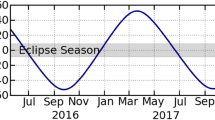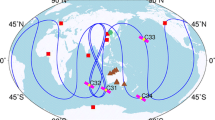Abstract
After comparing the modeled and the estimated yaw angles during yaw maneuvers for eight Block IIF Global Positioning System satellites over 1 year, we have observed discrepancies between the yaw directions in the vicinity of zero beta angle. Two features of the turn maneuvers are extracted after analysis of the observed differences: (1) The noon-turns reverse yaw direction when the beta angle falls between [−0.7°, 0°]; (2) midnight-turns always take the direction that completes <180° of total yaw. We present the approach implemented to account for the discrepancies between the observed and modeled yaw attitudes. In particular, an empirical beta angle bias is applied in the noon-turn model to correct the yaw direction error, and a short-route constraint is applied in the midnight-turn model for more robust performance.













Similar content being viewed by others
References
Bar-Sever Y (1996) A new model for GPS yaw attitude. J Geod 70(11):714–723
Bar-Sever YE, Bertiger WI, Davis ES (1996) Fixing the GPS bad attitude: modeling GPS Satellite yaw during eclipse seasons. Navigation 43(1):25–39
Colombo OL (2016) Testing a reverse kinematic point positioning technique for possible operational use in GPS data analysis at NASA’s Goddard space flight center. IGS workshop 2016, Sydney
Dilssner F (2010) GPS IIF-1 satellite antenna phase center and attitude modeling. Inside GNSS 5:59–64
Dilssner F, Springer T, Enderle W (2011) GPS IIF yaw attitude control during eclipse season, AGU Fall Meeting, San Francisco, 9 Dec. 2011. http://acc.igs.org/orbits/yaw-IIF_ESOC_agu11.pdf
Dow JM, Neilan RE, Rizos C (2009) The International GNSS Service in a changing landscape of Global Navigation Satellite Systems. J Geod 83(3–4):191–198. doi:10.1007/s00190-008-0300-3
Fliegel HF, Gallini TE, Swift ER (1992) Global Positioning System radiation force model for geodetic applications. J Geophys Res 97:559–568
Kouba J (2009) A simplified yaw-attitude model for eclipsing GPS satellites. GPS Solut 13(1):1–12
Kouba J (2013), Noon turns for deep eclipsing Block IIF GPS satellites, a note prepared for IGS ACs, dated 19 Dec, 2013 [IGS-ACS-930 Mail]
Kuang D, Rim HJ, Schutz BE, Abusali PAM (1996) Modeling GPS satellite attitude variation for precise orbit determination. J Geod 70(9):72–580
Weiss J, Bar-Sever Y, Bertiger W, Desai S, Harvey N, Sibthorpe A (2012) Modeling and characterization of the GPS Block II/IIA/IIF attitude. IGS Workshop 2012, Olsztyn
Wu JT, Wu SC, Hajj GA, Bertiger WI,Lichten SM (1993) Effects of Antenna Orientation on GPS Carrier Phase. Manuscripta Geod 18(2):91–98
Ziebart M, Dare P (2001) Analytical solar radiation pressure modeling for GLONASS using a pixel array. J Geod 75:587–599
Acknowledgments
The work described is carried out by the Jet Propulsion Laboratory, California Institute of Technology, under contract with the National Aeronautics and Space Administration. We are thankful to Yoaz Bar-Sever for helpful discussions on the original Block IIF GPS satellite yaw model. The effort by our colleagues in creating and maintaining the routine RPPP solutions of GPS satellites yaw attitude is gratefully appreciated. We also thank the two anonymous reviewers whose comments and suggestions broadened our knowledge about related studies in the IGS community and made this paper more robust.
Author information
Authors and Affiliations
Corresponding author
Rights and permissions
About this article
Cite this article
Kuang, D., Desai, S. & Sibois, A. Observed features of GPS Block IIF satellite yaw maneuvers and corresponding modeling. GPS Solut 21, 739–745 (2017). https://doi.org/10.1007/s10291-016-0562-9
Received:
Accepted:
Published:
Issue Date:
DOI: https://doi.org/10.1007/s10291-016-0562-9




